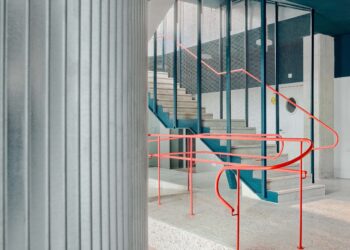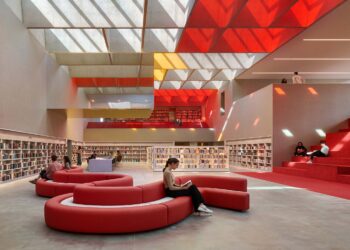Two distinct spatial halves make a whole in this Oregon riverside home
각자 특징이 살아있는 두 공간이 모여 하나의 건물이 된 오리건 주의 강변 주택
Landry Smith Architect | 랜드리 스미스 아키텍트

The Divine House is located along the McKenzie River outside of Eugene, Oregon, USA.
Approximately 50 feet above the water level, the structure is sited on the northern, upper end of a sloping lot overlooking a dramatic bend in the river. The house has a simple rectangular footprint and a gable roof with deep overhangs. It is directly organized down the centerline of the plan below the ridge. The northern half contains the smaller, more cellular programs: the carport, the entry, the guest area, the bathroom, and the primary bedroom. The southern half is entirely open and includes the living and dining areas, the kitchen, and an adjoining covered deck. The width of the rooms and the generous depth of the overhangs was based on the maximum length of local Douglas fir timber structural members.
미국 오리건 주 유진 외곽의 맥켄지 강 인근에 자리한 집이다. 강으로부터 약 15m 떨어진 북쪽 부지, 급히 휘돌아가는 강을 마주본 언덕 끝자락에 자리한 건물은 단순한 직육면체에 박공 지붕을 얹고 있는 모습이다. 지붕에서 가장 높은 부분을 중심선 삼아 그 아래로 공간이 대칭을 이루며 펼쳐진다. 집의 절반을 차지하는 북쪽 면은 차고와 현관, 응접실, 화장실, 메인 침실 등 작고 분리된 공간으로 채운 반면, 남쪽 면은 거실과 다이닝룸, 부엌, 지붕을 덮은 데크 등 넓고 개방적인 공간으로 꾸몄다. 이 지역에서 자라는, 키가 큰 더글러스 전나무 덕에 넉넉한 길이의 실내와 지붕을 제작하는 일이 가능했다.



The spaces of the house are defined using a series of “solid” volumes, which allow for multiple routes and free movement throughout the interior. Contained within this highly articulated poché are storage areas for clothing and household items, mechanical spaces, laundry area and bath. The volumes’ positioning reinforces the organization of the house along the ridgeline and establishes the distinct spatial character of the two halves of the plan.
Sightlines were developed to provide a range of views throughout the house and give an immediacy to the grounds and the river without undercutting privacy. Conceived as part of the main living room, an expansive hardwood deck extends out towards the river and will weather to a silver grey. The deck, which covers the same area as the interior of the house, works in tandem with the interior volumes to expand the field.



집 곳곳은 벽면에 숨은 여러 개의 공간이 연결된 구조로, 이에 따라 실내 전반에 걸쳐 다양한 동선과 자유로운 움직임을 만들어낸다. 긴밀히 연결된 이 공간 내부에는 의류와 가정용품을 보관하는 수납장, 기계실, 세탁실, 욕실 등이 자리한다. 이러한 공간 배치는 천장 능선에 따른 내부 구조를 보완할 뿐 아니라, 이등분된 실내에 독특한 개성을 부여한다.
건물 너머로 다채로운 풍경을 감상하고, 사생활 노출에 대한 걱정 없이 지면과 강을 가까이서 볼 수 있도록 시선 처리를 했다. 강을 향해 뻗어 나간, 거실의 일부를 이루는 넓은 목재 데크는 세월의 흐름에 따라 은회색으로 자연스럽게 바래질 것이다. 실내 면적에 맞먹는 크기의 이 데크는 내부 인테리어와 함께 야외 공간을 집으로 끌어들이는 역할을 한다.



The material palate and methods of construction are robust. The most prominent feature – the roof – is raw corrugated aluminum which will oxidize over time. It uses a concealed clip system installed over a grid of battens and counter battens, the latter of which also function as outriggers on the gable ends. The siding is 1.5m wide clear cedar planks, finished in black pine tar. They are furnished in full lengths and key precisely into the building geometry. Similar to the roof, the wall detail employs a fully vented assembly of battens and counter battens.
The interior is given a similar finished expression, in this case 1.5m wide plain sawn white oak boards, fully coordinated with the geometry throughout. The articulation (rather than the coloration) unifies the inside and the outside. The ceilings are installed over a lowered array of joists, lending intimacy to the spaces and concealing the beams below the roof ridge. The effect of suppressing the principal structure focuses the view out towards the landscape and, in concert with the storage volumes, lends the interior a strong sculptural quality, all enveloped in a single material. A hardwax oil was selected for the finish to maintain the raw appearance of the white oak.




견고한 재료와 공사 구조 또한 눈에 띈다. 제일 먼저 시선을 끄는 지붕은 시간이 흐르며 저절로 산화되는 물결 형태의 알루미늄 판을 사용했다. 널빤지로 만든 격자 프레임 위로 알루미늄 판을 씌운 은폐형 부착 방식을 적용하여 지붕을 올렸는데, 격자 프레임은 지붕 무게를 제어하는 아웃리거의 기능을 겸한다.
외장재의 경우1.5m 너비의 삼나무 널빤지를 절단하지 않고 벽면 높이에 맞추어 정확하게 재단한 뒤 검정색 소나무 타르를 발라 마감했다. 지붕과 마찬가지로, 벽면 또한 통풍이 잘 되도록 격자 모양의 각목 프레임을 적용했다.
1.5m 너비의 밝은색 오크 보드로 전체를 덮어 외장재와 유사한 느낌을 낸 실내는 내부와 외부를 서로 긴밀히 연결지으며 통일감을 준다. 낮게 배열된 장선 위로 천장을 올려 지붕 아래 서까래를 감추고 친근감 있는 공간을 연출했다. 전체적으로 절제된 구조가 야외 풍경에 대한 집중도를 높여주고, 벽면의 포셰이와 더불어 동일한 소재에서 비롯된 강렬한 조형적 특성을 전달한다. 밝은색 오크의 자연스러운 외관을 유지하도록 하드왁스 오일을 발라 마감했다.


Project: Divine House / Location: Springfield, Oregon / Architect: Landry Smith Architect / Completed: 2021 / Client: Roscoe Divine / Design Team: Landry Smith, Harrison Moser / Structural engineer: Munzing Structural Engineering / Lighting: Mariel Taviana Acevedo, Solus / Construction: Jay B Construction / Framing and finish carpentry: Green River Construction / Metalwork: Hanset Metal Fabricators / Program: single family house / Area: 3000 m² / Photography: ©Jeremy Bittermann




































